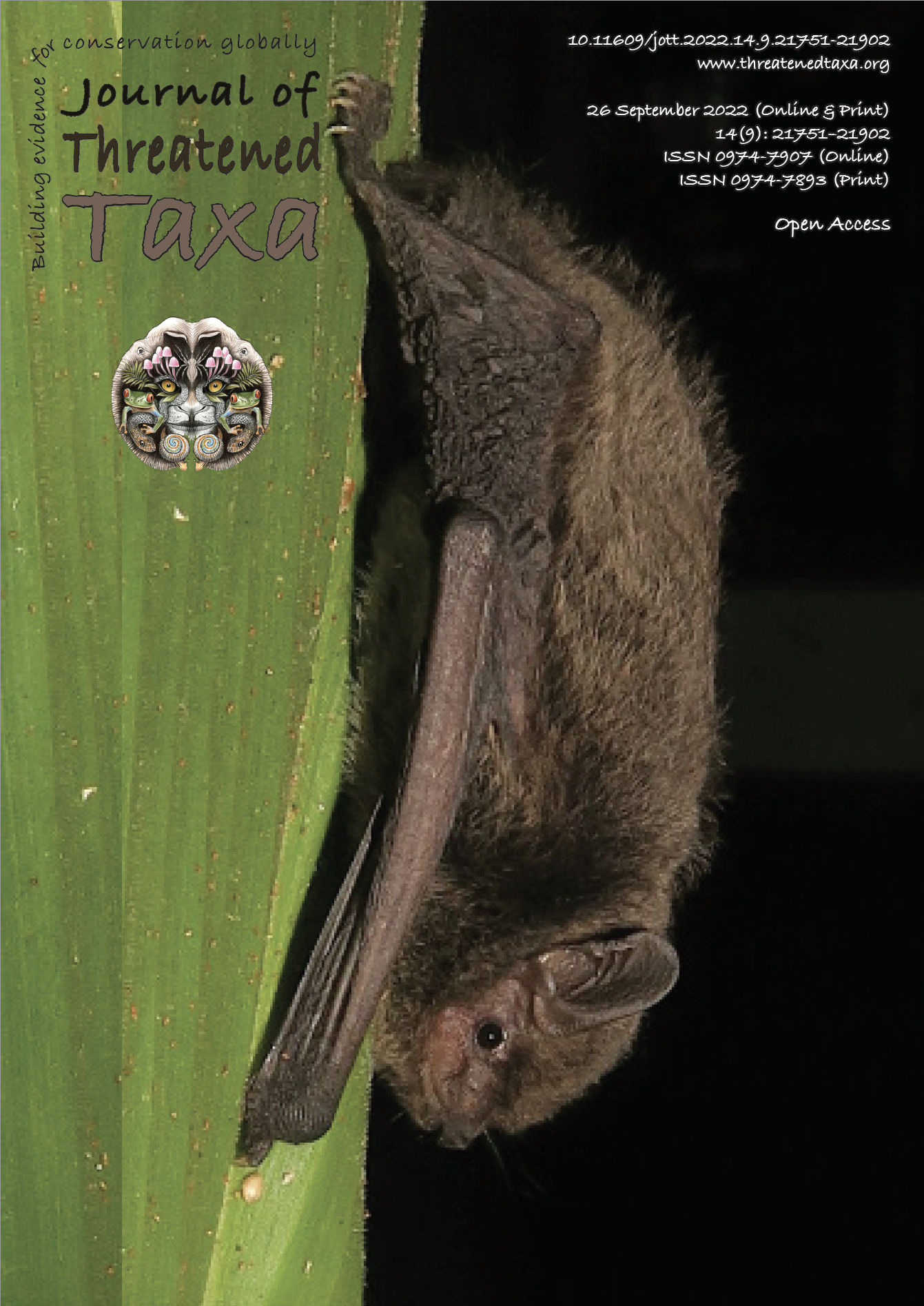Hematological value of captive Asian Elephants Elephas maximus around Chitwan National Park, Sauraha, Nepal
Main Article Content
Abstract
Veterinary hematology serves as an important screening procedure to assess general health conditions, diagnosis, and treatment of disease. This study aims to interpret and establish a set of hematology reference ranges for Asian Elephants managed by private and government facilities in Nepal. Blood samples from 50 elephants around Chitwan National Park, Sauraha were collected and hematological parameters such as total erythrocyte count and total leukocyte count were determined. The results show that the majority of hematological values were in line with the values previously published by different authors. The mean erythrocyte and leukocyte counts were reported as 3.32±0.93 × 10^6 cell/µL and 10448±335.49 cells/µL respectively. No sex-associated significant difference was observed in the case of total erythrocyte count, whereas total leukocyte counts varied significantly within sexes. Our findings revealed no significant difference in hematological parameters between government and privately owned elephants. The hematological values from our study can be used as reference values for assessing the health condition of elephants in Nepal. Further research work should be conducted to evaluate the factors affecting hematological parameters.
Article Details

This work is licensed under a Creative Commons Attribution 4.0 International License.
Authors own the copyright to the articles published in JoTT. This is indicated explicitly in each publication. The authors grant permission to the publisher Wildlife Information Liaison Development (WILD) Society to publish the article in the Journal of Threatened Taxa. The authors recognize WILD as the original publisher, and to sell hard copies of the Journal and article to any buyer. JoTT is registered under the Creative Commons Attribution 4.0 International License (CC BY), which allows authors to retain copyright ownership. Under this license the authors allow anyone to download, cite, use the data, modify, reprint, copy and distribute provided the authors and source of publication are credited through appropriate citations (e.g., Son et al. (2016). Bats (Mammalia: Chiroptera) of the southeastern Truong Son Mountains, Quang Ngai Province, Vietnam. Journal of Threatened Taxa 8(7): 8953–8969. https://doi.org/10.11609/jott.2785.8.7.8953-8969). Users of the data do not require specific permission from the authors or the publisher.
References
Addass, P.A., D.L. David, A. Edward, K. E.Zira & A. Midau (2012). Effect of age, sex and management system on some haematological parameters of intensively and semi‐intensively kept chicken in Mubi, Adamawa State, Nigeria. Iranian Journal of Applied Animal Science 2(3): 277–282.
Ajitkumar, G., K.S. Anil, P.C. Alex & T.S. Rajeev (2009). Healthcare management of captive Asian elephants. Kerala Agricultural University, Kerala, India, 40 pp.
Benjamin, M.M. (1978). Outline of Veterinary Clinical Pathology. Iowa State University Press, 351 pp.
Brown, I.R.F. & P.T. White (1980). Elephant blood haematology and chemistry. Comparative Biochemistry and Physiology Part B: Comparative Biochemistry 65(1): 1–12.
Debbie, J.G. & B. Clausen (1975). Some hematological values of free-ranging African elephants. Journal of Wildlife Diseases 11(1): 79–82.
Dutton, C.J. (2008). Biology, Medicine, and Surgery of Elephants. The Canadian Veterinary Journal 49(1): 45.
Egbe-Nwiyi, T.N., S.C. Nwaosu & H.A. Salami (2000). Haematological values of appararently healthy sheep and goats as influenced by age and sex in arid zone of Nigeria. African Journal of Biomedical Research 3(2): 109–115.
Etim, N.N., G.E. Enyenihi, M.E. Williams, M.D. Udo & E.E.A. Offiong (2013). Haematological parameters: indicators of the physiological status of farm animals. British Journal of Science 10(1): 33–45.
Gromadzka-Ostrowska, J., K. Jakubów, B. Zalewska & Z. Krzywicki (1988). Haematological and blood biochemical studies in female domesticated Indian Eelephants (Elaphas maximus L.). Comparative Biochemistry and Physiology. Part A: Physiology 89(3): 313–315. https://doi.org/10.1016/0300-9629(88)91031-6
Janyamethakul, T., S. Sripiboon, C. Somgird, P. Pongsopawijit, V. Panyapornwithaya, S. Klinhom, J. Loythong & C. Thitaram (2017). Tayland’da evcil asya filinin (Elephas maximus) kan ve biyokimyasal referans Aralıkları. Kafkas Universitesi Veteriner Fakultesi Dergisi 23(4): 665–668. https://doi.org/10.9775/kvfd.2017.17380
Lewis, J.H. (1974). Comparative hematology: studies on elephants, Elephas maximus. Comparative Biochemistry and Physiology Part A: Physiology 49(1): 175–181.
Miller, D., B. Jackson, H.S. Riddle, C. Stremme, D. Schmitt & T. Miller (2015). Elephant (Elephas maximus) health and management in Asia: Variations in veterinary perspectives. Veterinary Medicine International Volume 2015: Article ID 614690. https://doi.org/10.1155/2015/614690
Niemuller, C., P.A. Gentry & R. M. Liptrap (1990). Longitudinal study of haematological and biochemical constituents in blood of the Asian Elephant (Elephas maximus). Comparative Biochemistry and Physiology. A, Comparative Physiology 96(1): 131–134.
Nirmalan, G., S.G. Nair & K.J. Simon, (1967). Hematology of the Indian Elephant (Elephas maximus). Canadian Journal of Physiology and Pharmacology 45(6): 985–991.
Pradhan, N.M.B., A.C. Williams & M. Dhakal (2008). Current Status of Asian Elephants in Nepal, 35(January), 1–6. Retrieved from papers2://publication/uuid/28184549-15F1-4214-A472-A8D48B0F9FC9
Salakij, J., C. Salakij, N.-A. Narkkong, S. Apibal, P. Suthunmapinuntra, J. Rattanakukuprakarn, G. Nunklang & M. Yindee (2005). Hematology, cytochemistry and ultrastructure of blood cells from Asian Elephant (Elephas maximus). Agriculture and Natural Resources 39(3): 482–493.
Shrestha, R. (2007). A Case Study on Human-Wildlife Conflict in Nepal: with Particular Reference to Human-Elephant Conflict in Eastern and Western Terai Regions, 64 pp.
Silva, I.D. & V.Y. Kuruwita (1993). Hematology, plasma, and serum biochemistry values in free-ranging elephants (Elephas maximus ceylonicus) in Sri Lanka. Journal of Zoo and Wildlife Medicine 434–439.
Swenson, M.J. (1984). Physiological properties and cellular and chemical constituents of blood, pp. 15–40. In: Duke, H.H. (ed.). Dukes’ Physiology of Domestic Animals. Cornell University Press, USA.
Windberger, U., A. Bartholovitsch, R. Plasenzotti, K.J. Korak & G. Heinze (2003). Whole blood viscosity, plasma viscosity and erythrocyte aggregation in nine mammalian species: reference values and comparison of data. Experimental Physiology 88(3): 431–440.
Wolfrum, R. (2010). Introduction and approach. Recueil Des Cours, Collected Courses 272(2007): 165–196. https://doi.org/10.1163/ej.9789041112378.155-410.2
Woodford, M.H. (1979). Blood characteristics of the African Elephant (Loxodonta africana cyclotis). Journal of Wildlife Diseases 15(1): 111–113.
Yaqub, L.S., M.U. Kawu & J.O. Ayo (2013). Influence of reproductive cycle, sex, age and season on haematologic parameters in domestic animals. Journal of Cell Animal Biology 7(4): 37–43.
Young, E. & C.J. Lombard (1967). Physiological values of the African Elephant (Loxodonta africana). The Veterinarian 4: 169–172.

